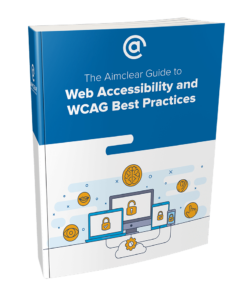
Disability is simply the mismatch between the design and a person.
What is WCAG and why is it important?
If you started thinking about websites and a WCAG checklist, that’s the wrong approach. There is no WCAG checklist and here’s why. If you make the site work for one disability you will inadvertently make it inaccessible for many others. We need to change the perception and get developers, designers, and content creators to start thinking WCAG is about people, not just process. Real people’s access to the websites, apps, videos, audio recordings, and documents available online. Everything published online needs to be available to people that utilize a screen reader, a dynamic braille display, a mounted tablet, etc. It also needs to consider those who have repetitive strain injuries, color blindness, cognitive or learning disabilities who can see but may have difficulty processing written text, over easily processing spoken language. While it can be overwhelming to consider all of the ability combinations, it is essential that all content provides equal access to people with these diverse abilities. As discussed in our Website Accessibility: Do the Right Thing blog post, the goal for any site owner should be to achieve – at a minimum – WCAG AA compliance. We’ve been working on the AIMCLEAR site and wanted to share our own ADA/WCAG journey as an example. We’ll highlight the laws that govern companies in the United States, who accessibility helps, the W3C international standards, how to write an accessibility statement, and the preliminary checks you can complete to build a game plan, as well as how to determine if it’s time to hire help.WCAG Section 508 & The Laws
If you need even more incentive to get your company moving to adopt web accessibility, the whisper of lawsuits might help. Lawsuits are tripling year over year. The Domino’s ADA Lawsuit presents a prime example. In short, their website and mobile app weren’t accessible in a way that a blind man could order a pizza. After losing in California, Domino’s petitioned the United States Supreme Court to hear their petition on October 07, 2019 and were denied. Be warned. There are a number of laws and policies in the United States that govern and protect the access to information or those with disabilities, including:- Americans with Disabilities Act of 1990 (ADA), as amended
- Section 508 of the US Rehabilitation Act of 1973, as amended
- Section 504 of the U.S. Rehabilitation Act of 1973, as amended
- Section 255 of the Telecommunications Act of 1996
- Air Carrier Access Act of 1986
- 21st Century Communications and Video Accessibility Act of 2010 (CVAA)
The AIMCLEAR Guide to Web Accessibility and WCAG Best Practices
A Guide to Help Make Your Content Accessible
5 Steps to WCAG Compliance and A Better User Experience
- Step 1: Web Accessibility Statement
- Step 2: Preliminary WCAG Tests and Checks
- Step 3: Going Mobile
- Step 4: Accessible Off and On-Page Elements (Your SEO was right)
- Step 5: Audio, Video, Forms and Design
Summary and Next Steps